Decarbonization
Race to Net Zero: Carbon Neutral Goals by Country
The following content is sponsored by the National Public Utilities Council
Race to Net Zero: Carbon Neutral Goals by Country
This was originally posted on July 8, 2021, on Visual Capitalist.
The time to talk about net zero goals is running out, and the time to put them into action is well underway.
At the U.S. Climate Summit in April 2021, U.S. President Biden pressured countries to either speed up carbon neutral pledges, or commit to them in the first place.
It’s a follow-up to the Paris Agreement, which keeps signatories committed to reaching carbon neutrality in emissions in the second half of the 21st century. But 2050–2100 is a wide timeframe, and climate change is becoming both increasingly present and more dire.
So when are countries committed to reaching net zero carbon emissions, and how serious is their pledge? This infographic from the National Public Utilities Council highlights the world’s carbon neutral pledges.
The Timeline of Carbon Neutral Targets by Country
The first question is how quickly countries are trying to get to net zero.
137 countries have committed to carbon neutrality, as tracked by the Energy and Climate Intelligence Unit and confirmed by pledges to the Carbon Neutrality Coalition and recent policy statements by governments.
But the earlier the pledge, the better, and most of the commitments are centered around 2050.
| Country | Target Year |
|---|---|
| Bhutan | Achieved |
| Suriname | Achieved |
| Uruguay | 2030 |
| Finland | 2035 |
| Austria | 2040 |
| Iceland | 2040 |
| Germany | 2045 |
| Sweden | 2045 |
| Afghanistan | 2050 |
| Andorra | 2050 |
| Angola | 2050 |
| Antigua and Barbuda | 2050 |
| Argentina | 2050 |
| Armenia | 2050 |
| Bahamas | 2050 |
| Bangladesh | 2050 |
| Barbados | 2050 |
| Belgium | 2050 |
| Belize | 2050 |
| Benin | 2050 |
| Brazil | 2050 |
| Bulgaria | 2050 |
| Burkina Faso | 2050 |
| Burundi | 2050 |
| Cabo Verde | 2050 |
| Cambodia | 2050 |
| Canada | 2050 |
| Central African Republic | 2050 |
| Chad | 2050 |
| Chile | 2050 |
| Colombia | 2050 |
| Comoros | 2050 |
| Cook Islands | 2050 |
| Costa Rica | 2050 |
| Croatia | 2050 |
| Cyprus | 2050 |
| Czechia | 2050 |
| Democratic Republic of Congo | 2050 |
| Denmark | 2050 |
| Djibouti | 2050 |
| Dominica | 2050 |
| Dominican Republic | 2050 |
| Ecuador | 2050 |
| Eritrea | 2050 |
| Estonia | 2050 |
| Ethiopia | 2050 |
| European Union | 2050 |
| Fiji | 2050 |
| France | 2050 |
| Gambia | 2050 |
| Greece | 2050 |
| Grenada | 2050 |
| Guinea | 2050 |
| Guinea-Bissau | 2050 |
| Guyana | 2050 |
| Haiti | 2050 |
| Hungary | 2050 |
| Ireland | 2050 |
| Italy | 2050 |
| Jamaica | 2050 |
| Japan | 2050 |
| Kiribati | 2050 |
| Laos | 2050 |
| Latvia | 2050 |
| Lebanon | 2050 |
| Lesotho | 2050 |
| Liberia | 2050 |
| Lithuania | 2050 |
| Luxembourg | 2050 |
| Madagascar | 2050 |
| Malawi | 2050 |
| Maldives | 2050 |
| Mali | 2050 |
| Malta | 2050 |
| Marshall Islands | 2050 |
| Mauritania | 2050 |
| Mauritius | 2050 |
| Mexico | 2050 |
| Micronesia | 2050 |
| Monaco | 2050 |
| Mozambique | 2050 |
| Myanmar | 2050 |
| Namibia | 2050 |
| Nauru | 2050 |
| Nepal | 2050 |
| Netherlands | 2050 |
| New Zealand | 2050 |
| Nicaragua | 2050 |
| Niger | 2050 |
| Niue | 2050 |
| Norway | 2050 |
| Pakistan | 2050 |
| Palau | 2050 |
| Panama | 2050 |
| Papua New Guinea | 2050 |
| Paraguay | 2050 |
| Peru | 2050 |
| Portugal | 2050 |
| Romania | 2050 |
| Rwanda | 2050 |
| Saint Kitts and Nevis | 2050 |
| Saint Lucia | 2050 |
| Saint Vincent and the Grenadines | 2050 |
| Samoa | 2050 |
| Sao Tome and Principe | 2050 |
| Senegal | 2050 |
| Seychelles | 2050 |
| Sierra Leone | 2050 |
| Slovakia | 2050 |
| Slovenia | 2050 |
| Solomon Islands | 2050 |
| Somalia | 2050 |
| South Africa | 2050 |
| South Korea | 2050 |
| South Sudan | 2050 |
| Spain | 2050 |
| Sudan | 2050 |
| Switzerland | 2050 |
| Tanzania | 2050 |
| Timor-Leste | 2050 |
| Togo | 2050 |
| Tonga | 2050 |
| Trinidad and Tobago | 2050 |
| Tuvalu | 2050 |
| U.S. | 2050 |
| Uganda | 2050 |
| United Kingdom | 2050 |
| Uzbekistan | 2050 |
| Vanuatu | 2050 |
| Vatican City | 2050 |
| Yemen | 2050 |
| Zambia | 2050 |
| China | 2060 |
| Kazakhstan | 2060 |
| Ukraine | 2060 |
| Australia | 2050 – 2100 |
| Singapore | 2050 – 2100 |
As far as early achievers go, Bhutan and Suriname are the only two countries that have achieved carbon neutrality and are actually carbon negative (removing more carbon than they emit). Uruguay’s 2030 target is the earliest to try and match that feat, followed by Europe’s Finland, Austria, Iceland, Germany, and Sweden, who are all targeting 2045 or earlier.
Over 90%, or 124 of the 137 countries tracked above, set a target of 2050 for reaching carbon neutrality. This is largely due to membership in the Carbon Neutrality Coalition, which asks member states to target 2050 for their goal but leaves commitment up to them.
Only five countries have net zero pledges set for after 2050, including Australia and Singapore, which haven’t set a firm target yet. Targeting 2060, in addition to Ukraine and Kazakhstan, is the world’s largest emitter, China. The country’s recent pledge is significant, since China accounts for an estimated 25% of global emissions.
In fact, according to the Climate Action Tracker, 73% of global emissions are currently covered by net zero targets.
How Seriously Are Countries Committing to Carbon Neutrality?
Setting a goal is perhaps the easiest step towards carbon neutrality. But the real challenge is in solidifying that goal and starting to make progress towards it. That’s why it’s important to consider how deeply committed each country’s carbon neutral pledge truly is.
The most rigid commitments are enshrined in law, followed by official government policy, though the latter can change alongside governments. Likewise, proposed legislation shows forward momentum in making pledges a reality, but proposals can take a long time to become enacted (or get derailed).
As it turns out, the vast majority of carbon neutral targets are only under discussion, with no formal action being taken to act on them.
| Country | Target Status |
|---|---|
| Bhutan | Achieved |
| Suriname | Achieved |
| Denmark | Law |
| France | Law |
| Hungary | Law |
| New Zealand | Law |
| Sweden | Law |
| United Kingdom | Law |
| Andorra | Policy Document |
| Australia | Policy Document |
| Austria | Policy Document |
| Brazil | Policy Document |
| China | Policy Document |
| Costa Rica | Policy Document |
| Finland | Policy Document |
| Germany | Policy Document |
| Iceland | Policy Document |
| Ireland | Policy Document |
| Japan | Policy Document |
| Kazakhstan | Policy Document |
| Marshall Islands | Policy Document |
| Norway | Policy Document |
| Panama | Policy Document |
| Paraguay | Policy Document |
| Portugal | Policy Document |
| Slovenia | Policy Document |
| South Africa | Policy Document |
| Switzerland | Policy Document |
| U.S. | Policy Document |
| Ukraine | Policy Document |
| Uzbekistan | Policy Document |
| Vatican City | Policy Document |
| Canada | Proposed Legislation |
| Chile | Proposed Legislation |
| European Union | Proposed Legislation |
| Fiji | Proposed Legislation |
| South Korea | Proposed Legislation |
| Spain | Proposed Legislation |
| Afghanistan | Under Discussion |
| Angola | Under Discussion |
| Antigua and Barbuda | Under Discussion |
| Argentina | Under Discussion |
| Armenia | Under Discussion |
| Bahamas | Under Discussion |
| Bangladesh | Under Discussion |
| Barbados | Under Discussion |
| Belgium | Under Discussion |
| Belize | Under Discussion |
| Benin | Under Discussion |
| Bulgaria | Under Discussion |
| Burkina Faso | Under Discussion |
| Burundi | Under Discussion |
| Cabo Verde | Under Discussion |
| Cambodia | Under Discussion |
| Central African Republic | Under Discussion |
| Chad | Under Discussion |
| Colombia | Under Discussion |
| Comoros | Under Discussion |
| Cook Islands | Under Discussion |
| Croatia | Under Discussion |
| Cyprus | Under Discussion |
| Czechia | Under Discussion |
| Democratic Republic of Congo | Under Discussion |
| Djibouti | Under Discussion |
| Dominica | Under Discussion |
| Dominican Republic | Under Discussion |
| Ecuador | Under Discussion |
| Eritrea | Under Discussion |
| Estonia | Under Discussion |
| Ethiopia | Under Discussion |
| Gambia | Under Discussion |
| Greece | Under Discussion |
| Grenada | Under Discussion |
| Guinea | Under Discussion |
| Guinea-Bissau | Under Discussion |
| Guyana | Under Discussion |
| Haiti | Under Discussion |
| Italy | Under Discussion |
| Jamaica | Under Discussion |
| Kiribati | Under Discussion |
| Laos | Under Discussion |
| Latvia | Under Discussion |
| Lebanon | Under Discussion |
| Lesotho | Under Discussion |
| Liberia | Under Discussion |
| Lithuania | Under Discussion |
| Luxembourg | Under Discussion |
| Madagascar | Under Discussion |
| Malawi | Under Discussion |
| Maldives | Under Discussion |
| Mali | Under Discussion |
| Malta | Under Discussion |
| Mauritania | Under Discussion |
| Mauritius | Under Discussion |
| Mexico | Under Discussion |
| Micronesia | Under Discussion |
| Monaco | Under Discussion |
| Mozambique | Under Discussion |
| Myanmar | Under Discussion |
| Namibia | Under Discussion |
| Nauru | Under Discussion |
| Nepal | Under Discussion |
| Netherlands | Under Discussion |
| Nicaragua | Under Discussion |
| Niger | Under Discussion |
| Niue | Under Discussion |
| Pakistan | Under Discussion |
| Palau | Under Discussion |
| Papua New Guinea | Under Discussion |
| Peru | Under Discussion |
| Romania | Under Discussion |
| Rwanda | Under Discussion |
| Saint Kitts and Nevis | Under Discussion |
| Saint Lucia | Under Discussion |
| Saint Vincent and the Grenadines | Under Discussion |
| Samoa | Under Discussion |
| Sao Tome and Principe | Under Discussion |
| Senegal | Under Discussion |
| Seychelles | Under Discussion |
| Sierra Leone | Under Discussion |
| Singapore | Under Discussion |
| Slovakia | Under Discussion |
| Solomon Islands | Under Discussion |
| Somalia | Under Discussion |
| South Sudan | Under Discussion |
| Sudan | Under Discussion |
| Tanzania | Under Discussion |
| Timor-Leste | Under Discussion |
| Togo | Under Discussion |
| Tonga | Under Discussion |
| Trinidad and Tobago | Under Discussion |
| Tuvalu | Under Discussion |
| Uganda | Under Discussion |
| Uruguay | Under Discussion |
| Vanuatu | Under Discussion |
| Yemen | Under Discussion |
| Zambia | Under Discussion |
Uruguay’s 2030 target might be the earliest, but it is not yet set in stone. The earliest commitment actually enshrined in law is Sweden’s 2045 target.
Including Sweden, only six countries have passed their carbon neutral targets into law. They include Denmark, France, Hungary, New Zealand, and the UK.
An additional five countries have proposed legislation in the works, including Canada and South Korea, as well as the entirety of the EU.
Meanwhile, 24 countries have their climate targets set as official policy. They include Brazil, China, Germany and the U.S., some of the world’s largest emitters.
99 of the 137 pledges are only under discussion at this time, or more than 72%. That means that they have no official standing as of yet, and are harder to act on. But as time starts to pass, pressure on countries to act on their carbon neutral pledges is beginning to grow.
The National Public Utilities Council is a collaborative body of industry experts coming together to solve decarbonization challenges in the power sector and the proud sponsor of the Decarbonization Channel.
Decarbonization
Unpacking Hydrogen’s Role in Decarbonizing the Electricity Sector
In this infographic, we discuss three ways hydrogen can support the decarbonization of the global electricity sector.

Hydrogen’s Role in Decarbonizing the Electricity Sector
Hydrogen constitutes 75% of the elemental mass in our universe.
According to the International Energy Agency (IEA), it could also play a pivotal role in global decarbonization efforts.
This infographic, created in partnership with the National Public Utilities Council, explores three ways this element could support the decarbonization of the global electricity sector.
Hydrogen 101
First, let’s get a few basics about hydrogen out of the way.
While abundant in nature, hydrogen is rarely found in its elemental state (H2) on Earth, meaning that it needs to be separated from other chemical compounds, such as water (H2O). Once extracted, however, it becomes a versatile and energy-dense fuel source, containing approximately three times the energy content of gasoline or natural gas.
There are several methods to extract hydrogen from compounds. Depending on the production method and energy source, the resulting hydrogen is often categorized by color to show its emission impact.
| Color | Hydrogen Production Method | Energy Source |
|---|---|---|
| Black | Gasification | Coal or Lignite |
| Gray | Steam Methane Reforming (SMR) | Natural Gas |
| Blue | SMR + Carbon Capture and Storage (CCS) | Natural Gas |
| Purple* | Electrolysis | Nuclear Energy |
| Green | Electrolysis | Renewable Energy |
*Purple hydrogen is also referred to as red or pink hydrogen.
Today, black, gray, and blue hydrogen are used in emission-heavy industries such as petroleum refining and ammonia production.
The technology and infrastructure for purple and green hydrogen, on the other hand, are still taking shape. As they progress, these emission-free sources of hydrogen are expected to play a pivotal role in decarbonizing many hard-to-abate sectors, including power.
Three Ways Green Hydrogen Can Help Decarbonize
Now that we’ve covered hydrogen basics, let’s dive into where emission-free hydrogen can fit in the race to decarbonize our global electricity system.
#1: Hydrogen and Natural Gas Blending
Hydrogen can be blended with natural gas in existing pipeline infrastructure for lower-emission power generation.
According to Jenbacher, a 20–30% hydrogen volume can lead to a 7–11% decrease in CO2 emissions, compared to natural gas on its own.
In 2022, U.S. electricity from natural gas generated 743 million metric tons in the United States. A 9% reduction in emissions through hydrogen blending lowers emissions by 67 million metric tons CO2, all without the need to build new infrastructure.
#2: Fuel Cells
A fuel cell generates electricity through an electrochemical reaction between hydrogen and oxygen, with water as the only byproduct.
By using green or pink hydrogen, fuel cells can provide 100% emission-free electricity that is also efficient, reliable, and dispatchable.
#3: Energy Storage
Energy storage plays a pivotal role in decarbonizing the power sector by balancing the intermittent nature of renewables.
While other technologies, such as lithium-ion batteries, can also provide energy storage, hydrogen has a greater potential to offer both large-scale and long-term storage, up to several months at a time.
As technology advances, the IEA predicts that global underground hydrogen capacity will grow by more than 200,000% in the next 30 years, reaching 1,200 TWh in 2050. That amount of energy can power 70,000 U.S. homes for an entire year, underscoring the untapped potential that lies within hydrogen.
Learn how the National Public Utilities Council is working towards the future of sustainable electricity.
Climate
Mapped: Global Temperature Rise by Country (2022-2100P)
In this set of three maps, we show the global temperature rise on a national level for 2022, 2050, and 2100 based on an analysis by Berkeley Earth.

Mapped: Global Temperature Rise by Country (2022-2100P)
Many scientific authorities, such as the Intergovernmental Panel on Climate Change (IPCC), often discuss the need to limit planetary warming to 2°C above pre-industrial levels.
But did you know that this warming will not be evenly distributed throughout the globe due to factors such as geography, weather patterns, ocean currents, and the influence of human activities?
To discover the current and projected nuances of this uneven warming, these three maps created in partnership with the National Public Utilities Council visualize the global temperature rise by country, using new and updated data from Berkeley Earth.
Current State of Warming
The three maps above visualize warming relative to each country’s average 1850-1900 temperatures.
Looking at warming in 2022, we see that average national warming (i.e. warming excluding oceans) is already 1.81°C above those numbers, with Mongolia warming the most (2.54°C) and Bangladesh warming the least (1.1°C).
As the map depicts, warming is generally more accelerated in the Global North. One of the reasons for this is Arctic amplification.
Arctic amplification refers to the disproportionate heating experienced in the Arctic compared to the rest of the planet. This amplification is fueled by multiple feedback loops, including decreased albedo as ice cover diminishes, leading to further absorption of heat and exacerbating the warming effect.
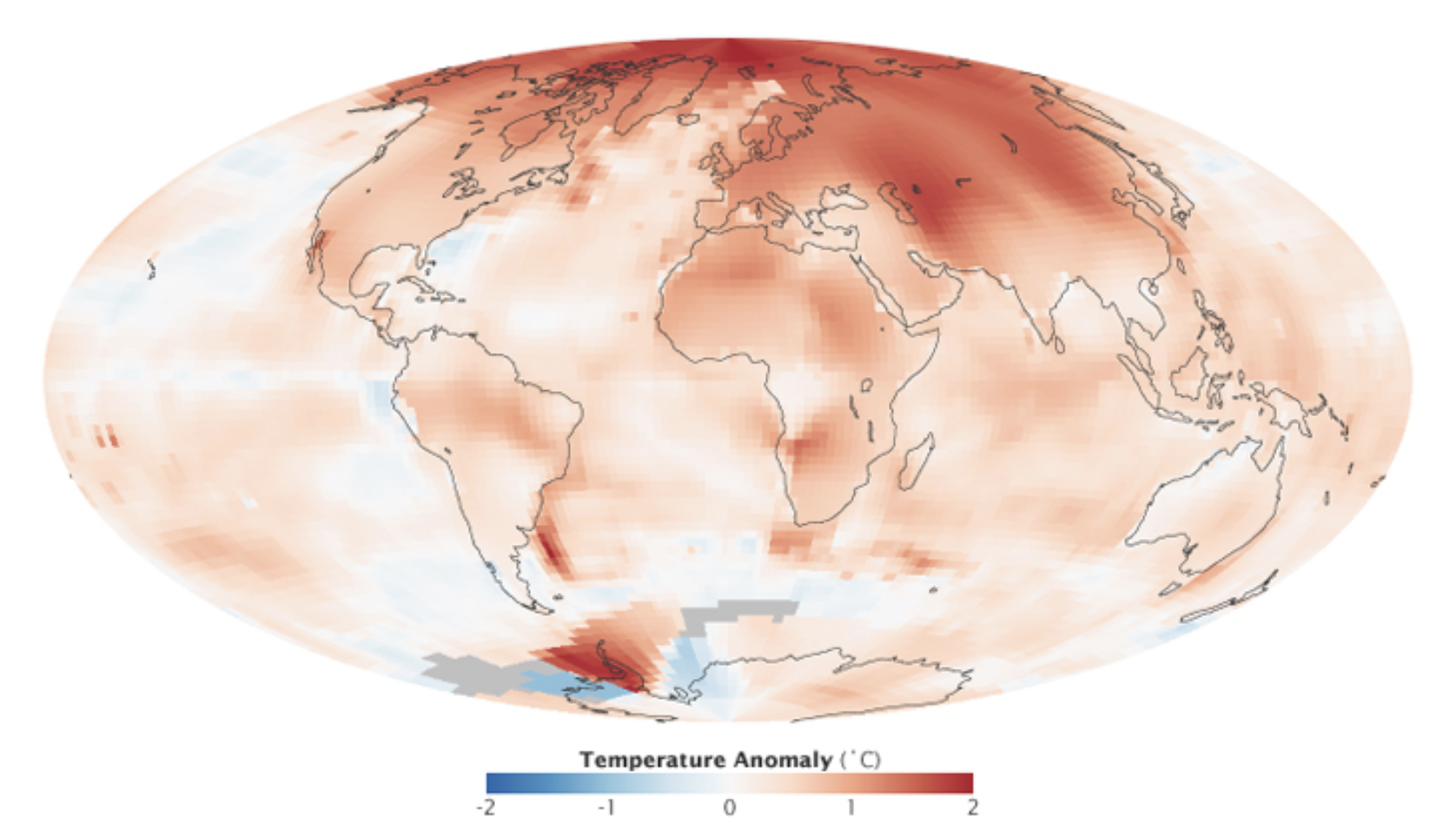
Arctic amplification. Source: NASA
Aside from modern-day observations, the effects of Arctic amplification are also clearly seen in climate models, where accelerated warming in countries such as Russia and Canada is seen through 2100.
Projected Warming in 2050 and 2100
Moving over to the second and third maps in the slides above, we discover country-level 2050 and 2100 warming projections.
These projections are based on the IPCC’s “middle-of-the-road” scenario, titled Shared Socioeconomic Pathway (SSP) 2-4.5. Out of the various established pathways, this one is the closest to expected emissions under current policies.
2050 Projections
Under the SSP2-4.5 scenario, average national warming is projected to be 2.75°C above average 1850-1900 temperatures in 2050. This includes Mongolia, with the most substantial warming of 3.76°C, and New Zealand, with the mildest warming of 2.02°C.
To put those temperatures into context, here are the risks that would likely accompany them, according to the IPCC’s latest assessment report.
- Extreme weather events will be more frequent and intense, including heavy precipitation and related flooding and cyclones.
- Nearly all ecosystems will face high risks of biodiversity loss, including terrestrial, freshwater, coastal and marine ecosystems.
- Accelerated sea level rise will threaten coastal cities, leading to mass displacement.
Let’s now take a look at 2100 projections, which would have significantly higher levels of risk unless fast and extreme mitigation and adaptation measures are implemented in the upcoming decades.
2100 Projections
2100 projections under the SSP2-4.5 scenario depict an average national warming of 3.80°C.
More than 55 countries across the globe are projected to have warming above 4°C in comparison to their 1850-1900 averages, and nearly 100 above 3.5°C.
Here is what those levels of warming would likely mean, according to the IPCC.
- 3-39% of terrestrial species will face very high risks of extinction.
- Water scarcity will considerably affect cities, farms, and hydro plants, and about 10% of the world’s land area will experience rises in both exceptionally high and exceptionally low river flows.
- Droughts, floods, and heatwaves will pose substantial threats to global food production and accessibility, eroding food security and impacting nutritional stability on a significant scale.
Generally, warming at this level is expected to pose substantial catastrophic risks to humanity, necessitating swift and bold climate action.
Learn more about how electric utilities and the power sector can lead on the path toward decarbonization here.
-
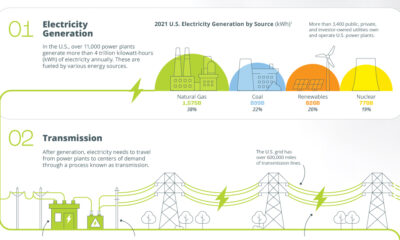
 Electrification1 year ago
Electrification1 year agoVisualized: How the Power Grid Works
-
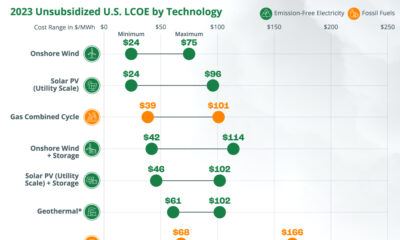
 Energy Shift9 months ago
Energy Shift9 months agoRanked: The Cheapest Sources of Electricity in the U.S.
-
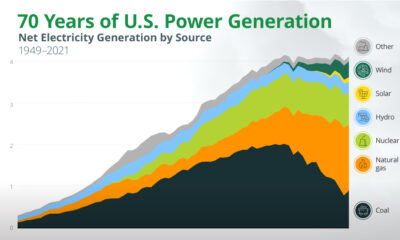
 Energy Shift1 year ago
Energy Shift1 year agoAnimated: 70 Years of U.S. Electricity Generation by Source
-

 Clean Energy1 year ago
Clean Energy1 year agoBreaking Down Clean Energy Funding in the Inflation Reduction Act
-
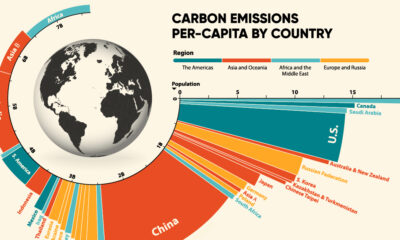
 Emissions1 year ago
Emissions1 year agoVisualizing Global Per Capita CO2 Emissions
-
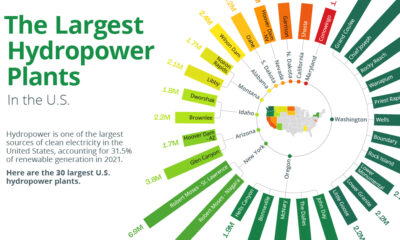
 Clean Energy1 year ago
Clean Energy1 year agoThe 30 Largest U.S. Hydropower Plants
-
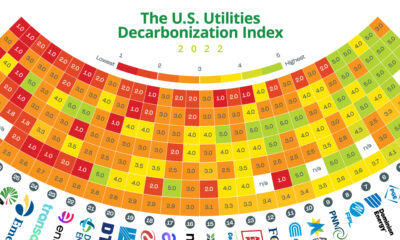
 Decarbonization1 year ago
Decarbonization1 year agoThe U.S. Utilities Decarbonization Index
-

 Clean Energy6 months ago
Clean Energy6 months agoBreaking Down the $110 Trillion Cost of the Clean Energy Transition


